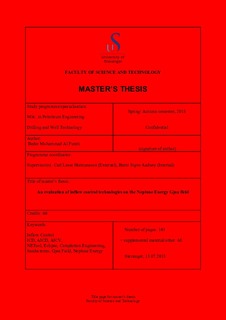| dc.contributor.advisor | Hermansson, Lasse | |
| dc.contributor.advisor | Aadnøy, Bernt Sigve | |
| dc.contributor.author | Al Furati, Beder Mohammad | |
| dc.date.accessioned | 2018-10-23T15:06:51Z | |
| dc.date.available | 2018-10-23T15:06:51Z | |
| dc.date.issued | 2018-07 | |
| dc.identifier.uri | http://hdl.handle.net/11250/2569207 | |
| dc.description | Master's thesis in Petroleum Engineering | nb_NO |
| dc.description.abstract | Operators are constantly looking for new ways to increase production and recovery in oil and gas wells by application of Intelligent Well Completions and Inflow Control Technology (ICT). For the latter, one of the main challenges is to quantify the potential upside with the application of this technology.
In this context, dynamic simulators such as Eclipse and static simulators such as Landmark NETool are commonly used to try and demonstrate a change in production behavior compared to a conventional completion. The traditional way of doing this is to simulate and predict performance using a preliminary reservoir model prior to drilling the wells. This can present a series of uncertainties, and it all comes down to the accuracy of the geological understanding and reservoir approximations. It can lead to false conclusions based on poor and erroneous models. Additionally, lack of understanding of how inflow control technology works, combined with conservatism, often makes a non-ICT completion the default go-to strategy when it comes completing new wells.
In this study, a different approach to the challenge was pursued. Together with Neptune Energy Norway, two existing oil wells on the Gjøa field were analyzed.
At the time of construction, these wells were not completed with IC Technology. The objective of the study was to investigate whether or not an ICT completion would have been beneficial in terms of improved oil recovery, and/or lower gas/water production, and potentially to what degree. The main methodology was based on establishing Landmark NETool models with input from the existing reservoir model, and subsequently calibrating the models to match the production history of the wells. The well designs were then modified to include different types of inflow control technologies.
The two candidate oil wells chosen for the study indicated different behaviors with the inclusion of inflow control. Well B3, which suffered from excessive gas production, showed promising results with both standard nozzle-ICDs and with AICVs. This can be attributed to the mitigation of the heel-toe effect and restrictive choking of gas producing intervals which promoted production from the toe of the well. On the other hand, well B1 did not show significant improvements when simulated with ICT. Previously suffering from excessive water production and immobilized the oil reserves, the results showed an increase in water production both with standard and autonomous inflow control. This result is however linked to some uncertainties.
There are also other significant benefits to ICT that can justify the inclusion of inflow control in the well design. | nb_NO |
| dc.language.iso | eng | nb_NO |
| dc.publisher | University of Stavanger, Norway | nb_NO |
| dc.relation.ispartofseries | Masteroppgave/UIS-TN-IEP/2018; | |
| dc.rights | Navngivelse-Ikkekommersiell 4.0 Internasjonal | * |
| dc.rights.uri | http://creativecommons.org/licenses/by-nc/4.0/deed.no | * |
| dc.subject | petroleumsteknologi | nb_NO |
| dc.subject | petroleum engineering | nb_NO |
| dc.subject | ICD | nb_NO |
| dc.subject | AICD | nb_NO |
| dc.subject | AICV | nb_NO |
| dc.subject | NETool | nb_NO |
| dc.subject | Eclipse | nb_NO |
| dc.subject | Neptune Energy | nb_NO |
| dc.subject | Sandscreen completions | nb_NO |
| dc.subject | Gjøa | nb_NO |
| dc.subject | inflow control | nb_NO |
| dc.subject | completion engineering | nb_NO |
| dc.title | An evaluation of inflow control technologies on the Neptune Energy Gjøa field | nb_NO |
| dc.type | Master thesis | nb_NO |
| dc.description.version | submittedVersion | nb_NO |
| dc.subject.nsi | VDP::Teknologi: 500::Berg‑ og petroleumsfag: 510::Petroleumsteknologi: 512 | nb_NO |

